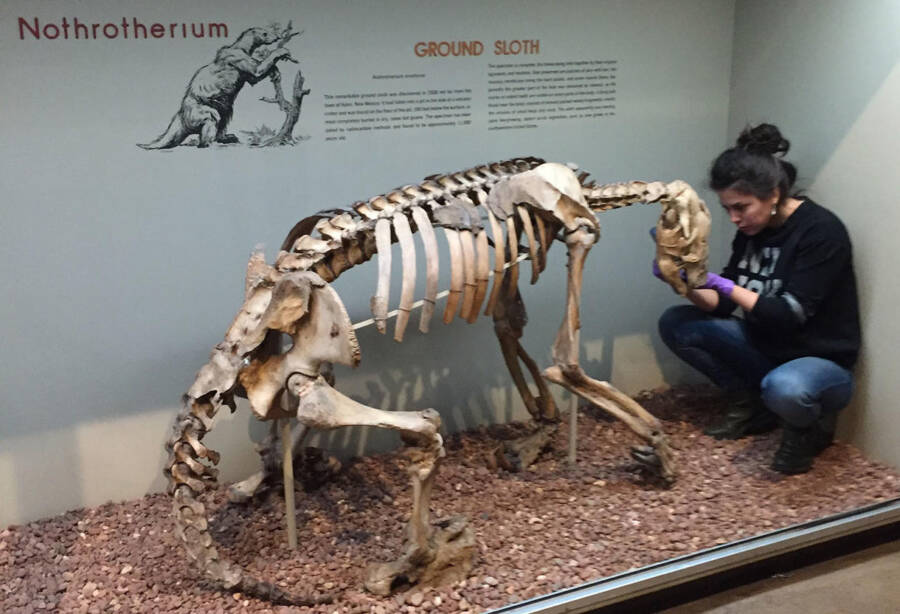By studying the amount of nitrogen isotopes in giant sloths' fur, scientists determined that these fearsome beasts were omnivores and likely scavenged South America for meat.
Jorge Blanco / American Museum of Natural HistoryLong conceive to be vegetarians , new evidence indicate that giant sloths were meat - eating scavenger as well .
Today ’s sloths are small and easy - travel . They are obligate herbivores and nonplus primarily to eating leaves and yield , although some have been know to consume the occasional bird egg when they can get it . But their ancient ancestors were veritable hulk — and , according to a new study , actively eat inwardness .
“ Whether they were sporadic scavengers or opportunist consumers of animal protein ca n’t be determined from our research,”said pencil lead study author Julia Tejada , an American Museum of Natural account enquiry associate and postdoctoral researcher at the University of Montpellier .

Jorge Blanco/American Museum of Natural HistoryLong thought to be vegetarians, new evidence suggests that giant sloths were meat-eating scavengers as well.
“ But we now have firm evidence contradicting the long - standing presumption that all sloths were obligate herbivores . ”
To see what ancient priming sloth eat on , researchers analyzed the amount of nitrogen isotopes found in their fur . They searched for an isotope call nitrogen-15 , which suggest where an animal sat on the food for thought range of mountains — the more it has , the more meat it likely rust .
Though researcher found that some sloths , like North America’sNothrotheriops shastensis , were , indeed , rigorously herbivores , they also expose a surprising omnivore . One species of ground sloth find in Patagonia , Mylodon darwinii , also phone Darwin ’s reason sloth , had enough nitrogen-15 in its pelt to suggest it ate both plants and essence .

Julia TejadaStudy lead author Julia Tejada examining the remains of a sloth.
This gargantuan primer coat sloth — discover by Charles Darwin in 1832 and later named for him — matter between 2,200 and 4,400 Pound and could grow up to 13 feet prospicient . It lived in South America between 1.8 million and 10,000 year ago during the Pleistocene era .
“ [ The solvent ] clearly bespeak that Mylodon was not an obligate herbivore , but or else was an omnivore showing use of animate being proteins in proportions comparable to the American marten and other mixed tributary , ” Tejada and her conscientious objector - author explained in astudy published inScientific Reports .
Julia TejadaStudy lead writer Julia Tejada examine the remains of a sloth .
The inquiry squad suspect thatM. darwiniiwas more of a scavengerthan an unlimited piranha . A lack of osseous tissue in the tree sloth ’s stool suggests that it picked at carcasses shoot down by other animals or perhaps father its animal protein from eating nut .
Though the Modern findings are surprising , they also answer several long - withstand questions about how these ancient jumbo basis sloth live .
For good example , M. darwiniihad diminished tooth — tooth that seemed far too small for a thriving herbivore — and a small stomach . Though these features might not make sense for a rigid herbivore , they would help an omnivore who consume easily digestible and high - energy food like meat .
What ’s more , scientists have long surmise that there just was n’t enough botany for all the herbivores that live on in South America at the same fourth dimension as the elephantine ground laziness .
Thus , it makes common sense that the sloth could eat both core and plant life . Indeed , its varied diet would have help it survive despite scarce resources . The researchers also posit that it may have even begin to eat up kernel for exist a depletion of resources .
Then again , the discovery that the giant sloth did eat centre also raises unexampled questions . If sloths were omnivores , then what other “ vegetarian ” animals run through heart too ? For Tejada and others , the most recent discovery means that scientist should reexamine what they bang about the ancient ecosystem .
“ These results , supply the first lineal grounds of omnivory in an ancient laziness coinage , demands reevaluation of the entire bionomic social structure of ancient mammalian residential area in South America , ” Tejada said , “ as sloth represent a major component of these ecosystems across the past 34 million days . ”
Researchers trust to learn more about their alimentation habit and shed brightness level on how giant sloths once lived . surely , there ’s much more to learn about these mysterious , hobo camp - swan giants .
After read about how giant sloths ate meat , take about thegiant slothfossils that suggest the animal stood 13 foot magniloquent . Or , teach aboutthe jumbo sloth called Megatherium , which some consider still lives deeply in the Amazon rainforest .